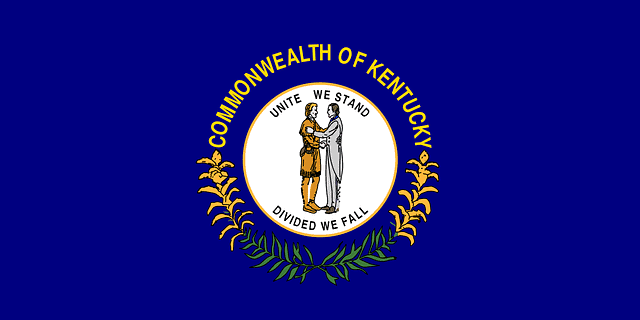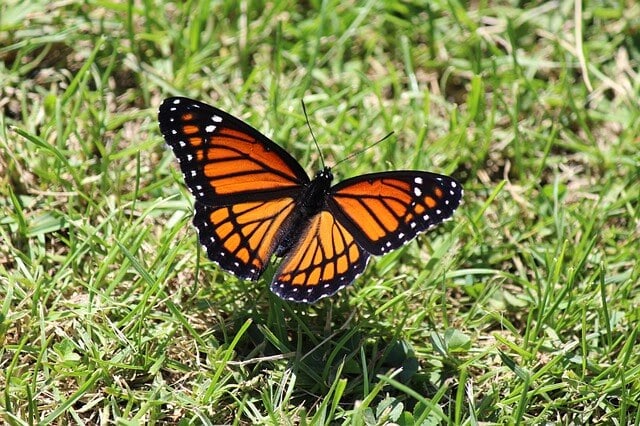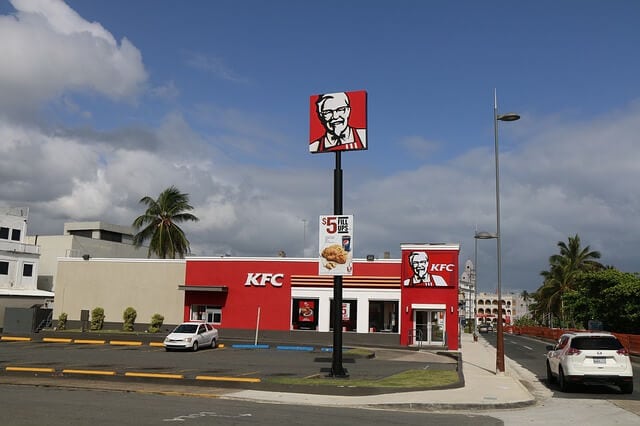
Table of Contents
Kentucky is a Commonwealth state of the U.S., located in the country’s southern region. It joined the Union in 1792 as the 15th state, breaking away from Virginia in the process. Today, Kentucky is one of the most extensive and most populous states of the U.S.
Known as the ‘Bluegrass State’, a nickname based on the species of grass commonly found in many of its pastures, Kentucky is home to the longest cave system in the world: Mammoth Cave National Park. It’s also famous for its bourbon, horse racing, tobacco and of course – Kentucky Fried Chicken.
In this article, we’ll be going through some of the most well-known state symbols of Kentucky, both official and unofficial.
Flag of Kentucky

The Kentucky state flag features the Commonwealth’s seal on a navy-blue background with the words ‘Commonwealth of Kentucky’ over it and two sprigs of goldenrod (the state flower) below it. Under the goldenrod is the year 1792, when Kentucky became a U.S. state.
Designed by Jesse Burgess, an art teacher in the state capital, Frankfort, the flag was adopted by the General Assembly of Kentucky in 1918. In 2001, the flag ranked 66th in a survey conducted by the North American Vexillological Association on the designs of 72 Canadian, U.S. territorial and U.S. state flags.
The Great Seal of Kentucky
The Kentucky seal consists of a simple image of two men, a frontiersman and a statesman, one in formal dress and the other one dressed in buckskin. They’re facing each other with their hands clasped. The frontiersman symbolizes the spirit of the Kentucky frontier settlers whereas the statesman represents the people of Kentucky who served their nation and state in the halls of government.
The inner circle of the seal contains the state motto ‘United we stand, Divided we fall’ and the outer ring is adorned with the words ‘Commonwealth of Kentucky’. The Great Seal was adopted in 1792, just 6 months after Kentucky became a state.
State Dance: Clogging
Clogging is a type of American folk dance in which the dancers use their footwear to create audible rhythms by striking the toe, heel or both against the floor percussively. It’s usually performed to a downbeat with the dancer’s heel keeping the rhythm.
In the U.S., team or group clogging originated from the square dance teams in the Mountain Dance and Folk Festival of 1928. It was popularized by minstrel performers back in the late 19th century. Many fairs and folk festivals utilize dancing teams or clubs to perform clogging for entertainment. In 2006, clogging was designated the official state dance of Kentucky.
State Bridge: Switzer Covered Bridge
The Switzer Covered Bridge is located over the North Elkhorn Creek near Switzer Kentucky. Built in 1855 by George Hockensmith, the bridge is 60 feet long and 11 feet wide. In 1953 it was threatened with destruction but was restored. Unfortunately, later on, it was swept entirely off its foundation due to high water levels. During this time the bridge had to be closed to traffic until it was rebuilt.
In 1974, the Switzer Covered Bridge was listed on the National Register of Historic Places and it was named the official covered bridge of the state of Kentucky in 1998.
State Gem: Freshwater Pearls

Freshwater pearls are pearls that are created and farmed using freshwater mussels. These are produced in the U.S. on a limited scale. In the past, natural freshwater pearls were found throughout the Tennessee and Mississippi River valleys but the population of natural pearl-producing mussels decreased due to increased pollution, over-harvesting and damming of the rivers. Today, mussels are cultivated through certain artificial processes on what are called ‘pearl farms’ along the Kentucky Lake in Tennessee.
In 1986, the schoolchildren of Kentucky proposed the freshwater pearl as the official state gemstone and the General Assembly of the state made it official later that year.
State Pipe Band: Louisville Pipe Band
The Louisville Pipe Band is a charitable non-profit corporation, sustained by private donations, performance fees and corporate sponsorships to support scholarships for students to attend drumming and pip summer schools, teaching programs and for travelling to competitions in Georgia, Indiana, Ohio and Kentucky. Although the band’s roots lead back to 1978, it was officially organized in 1988 and is one of the only two competitive bagpipe bands in the state.
The band is also registered with the Eastern United States Pipe Band Association which is one of the most respected and largest bagpipe associations in the nation. The Louisville band was designated as the official pipe band of Kentucky by the General Assembly in 2000.
Fordsville Tug of War Championship

Tug-of-war, also known as tug war, rope war, tugging war or rope pulling, is a test of strength, requiring only a single piece of equipment: a rope. In one contest, two teams hold onto opposite ends of the rope, (one team on each side) and pull with the goal of bringing the rope across the center line in either direction, against the force of the other team’s pull.
Although the origins of this sport remain unknown, it is thought to be ancient. Tug of war has been an extremely popular sport throughout the history of Kentucky and in 1990, The Fordsville Tug-of-War Championship, an event that takes place every year in Fordsville, Kentucky, was designated the official tug-of-war championship of the state.
State Tree: Tulip Poplar
The tulip poplar, also called yellow poplar, tulip tree, whitewood and fiddletree is a large tree that grows to move than 50m in height. Native to eastern North America, the tree is fast-growing, but without the typical issues of short lifespan and weak wood strength that’s usually seen in fast-growing species.
Tulip poplars are usually recommended as shade trees. It’s a significant honey plant which yields a fairly strong, dark reddish honey, not suitable for table honey but is said to be favorably regarded by certain bakers. In 1994, the tulip poplar was named the official state tree of Kentucky.
Kentucky Science Center
Previously known as the ‘Louisville Museum of Natural History and Science’, the Kentucky Science Center is the largest science museum in the state. Located in Louisville, the museum is a non-profit organization that was founded as a natural history collection back in 1871. Since then, several extensions have been added to the museum including a four-story digital theater and a Science Education Wing on the first floor of the building. It also has four science-workshop labs that are fully equipped for people to participate in hands-on activities.
The Science Center was designated the official science center of Kentucky in 2002. It remains an important symbol of the state and more than half a million people visit it each year.
State Butterfly: Viceroy Butterfly

The viceroy butterfly is a North American insect commonly found throughout the U.S. states, as well as in parts of Canada and Mexico. It’s often mistaken for the monarch butterfly since their wings are similar in color, but they’re a distantly related species.
It’s said that the viceroy mimics the poisonous monarch as a way of protecting itself from predators. However, viceroys are far smaller than monarch butterflies and they don’t migrate.
In 1990, the state of Kentucky designated the viceroy as the official state butterfly. The viceroy’s host plant is the tulip poplar (the state tree) or the willow tree, and the butterfly’s emergence depends on the development of the leaves on its host tree.
State Rock: Kentucky Agate
Kentucky agates are one of the most prized types of agate in the world because of their deep, varied colors that are arranged in layers. Agate is a rock formation which contains quartz and chalcedony as the primary components. It has various colors and is formed primarily within metamorphic and volcanic rocks. The color banding usually depends on the chemical impurities of the rock.
In July of 2000, the Kentucky agate was designated as the official state rock, but this decision was taken without consulting the state’s Geological Survey first which was unfortunate because agate is actually a type of mineral and not a rock. It turns out Kentucky’s state rock is actually a mineral and the state mineral, which is coal, is actually a rock.
Bernheim Arboretum & Research Forest
The Bernheim Arboretum and Research Forest is a large nature preserve, forest and arboretum which occupies 15,625 acres of land in Clermont, Kentucky. It was founded by Isaac Wolfe Bernheim, a German immigrant in 1929 who purchased the land at just $1 an acre. At the time, the land was considered quite useless, since most of it was stripped for the mining of iron ore. Construction of the park began in 1931 and once completed, the Forest was given in trust to the people of Kentucky.
The Forest is the largest natural area in the state that’s been privately owned . The tombs of Bernheim, his wife, son-in-law and daughter can all be found in the park. It was designated the official arboretum of the state of Kentucky in 1994 and it welcomes more than 250,000 visitors every year.
Kentucky Fried Chicken

Kentucky Fried Chicken, popularly known around the world as KFC, is an American fast-food restaurant chain that’s headquartered in Louisville, Kentucky. It specializes in fried chicken and is the second-largest restaurant chain in the world, after McDonalds.
KFC came into existence when Colonel Harland Sanders, an entrepreneur, began to sell fried chicken from a little roadside restaurant he owned in Corbin, Kentucky during the time of the Great Depression. In 1952, the first ‘Kentucky Fried Chicken’ franchise opened in Utah and quickly became a hit.
Harland branded himself as ‘Colonel Sanders’, becoming a prominent figure of the cultural history of America and even today his image is extensively used in KFC advertising. However, the rapid expansion of the company overwhelmed him and he finally sold it to a group of investors in 1964. Today, KFC is a household name, known all over the globe.
Check out our related articles on other popular state symbols:








